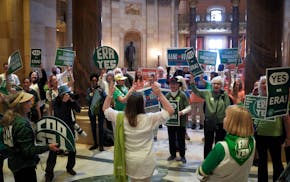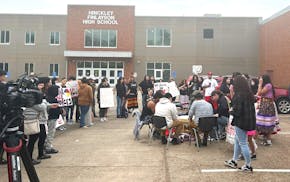Opinion editor's note: Editorials represent the opinions of the Star Tribune Editorial Board, which operates independently from the newsroom.
•••
As usual, a behind-the-scenes tussle is unfolding over proposals to fund public safety proposals at the State Capitol. But it's not the usual tussle.
This time it's DFL Gov. Tim Walz vs. his DFL colleagues in the House and Senate.
Minnesota faces a multiplicity of problems in this area. A serious shortage exists statewide among police and sheriffs' deputies, with more retiring every day. Violent crime, while declining a bit in the metro area, remains disturbingly high, and in Minneapolis auto thefts are running at twice the rate of this time last year.
Communities everywhere are searching for the right balance among prevention, enforcement and oversight, and for the resources to do the job well.
That makes for an all-hands — and all-solutions — on-deck situation. Walz, for the second year in a row, has proposed sending one-time surplus funds to local governments across the state, for them to allocate to the public safety needs particular to their communities. That proposal fell victim to last year's gridlock in a divided Legislature.
This year, Walz rightly bumped his proposal up to $550 million, but is running into a distinct lack of support from House and Senate DFLers. Just four senators had sponsored a bill for the governor's proposal. The governor's office on Friday confirmed that there is no House companion bill in any committee.
Rep. Cedrick Frazier, DFL-New Hope, was quoted in one news report saying there was little support in his caucus for sending money to local governments to use at their discretion. Frazier said he prefers to target the highest-crime areas, with an emphasis on violence prevention and intervention programs.
The Senate passed its $880 million public safety bill on Friday, with Sen. Ron Latz, DFL-St. Louis Park and chair of the Judiciary and Public Safety Committee, calling it a "well-balanced" bill intended to catch up on backlogs while also looking longer-term. "The only way we're going to bend the curve long term is to identify and take care of those youth that show signs of going down the wrong path," he said.
Long-term strategies that emphasize innovation are good. And the Senate investments in courts, public defenders and mental health programs are all necessary. Frazier's desire to target the highest-crime areas makes sense. Rep. Kelly Moller, DFL-Shoreview, chair of the public safety committee, said the House bill has money for violence interrupters, prevention efforts, mental health and more, as well as a probation effort supported by all 87 counties.
But surely, in a state with an $18 billion surplus, there is room, amid all these longer-term prescriptive efforts, to send some flexible, one-time money to local communities desperate for funds to help with their particular public safety needs.
Rep. Paul Novotny of Elk River, the Republican lead on public safety matters, told an editorial writer that "my read on this is the governor is thinking more statewide and [House members] are looking more at their areas of interest." Novotny, who serves on the Peace Officers Standards and Training (POST) advisory board, said that "I know right now we're about 2,000 short on licensed peace officers. More are retiring every day. The people in the pipeline can't cover that. We're in a bad spot and we are one incident away — anywhere in this state — from being in a much worse spot."
Police are active partners — and a necessary component — in any comprehensive strategy to make communities safe. Yes, there must be strong oversight. No, cops can't be the answer to everything. Other proactive pieces must play valuable roles.
Brooklyn Park Mayor Hollies Winston told an editorial writer that his city has been working hard to create what he calls "Brooklyn Park Police 3.0," a model that will include better information sharing with surrounding cities and innovative strategies for targeting scarce resources.
The Walz proposal, which allocates specific amounts to localities, "may be one-time money," Winston said, "but it is going to help us bridge costs in all kinds of ways: prevention efforts, interrupter programs, hiring more and better police, all while we look for longer-term dollars."
Those efforts are underway in many parts of the state. Minneapolis has a new police chief, and Hennepin County, thankfully, a new sheriff — the tough-minded Dawanna Witt. Both joined Winston in a news conference pleading for the state to send public safety funds they can use for their specific needs. Witt said the money represented "a once-in-a-generation opportunity to address our staffing shortages and advance compassionate and effective law enforcement."
Winston said he appreciates all the plans, grants and longer-term efforts. "But we need some flexible spending that can go directly to people who are grappling with crime on a daily basis," he said. "We need that money and we needed it yesterday."
Winston had one other message for the Legislature as it moves toward final allocations: "Do not penalize Brooklyn Park and others moving toward that 3.0 model," he said. "We will get those dollars and put them to work right away, with police who understand what we're doing, who are dedicated to this new model and who are leading those efforts."
Public safety, Winston said, "is our number one priority, because we know that nothing else works if people don't feel safe."
Editorial Board members are David Banks, Jill Burcum, Scott Gillespie, Denise Johnson, Patricia Lopez, John Rash and D.J. Tice. Star Tribune Opinion staff members Maggie Kelly and Elena Neuzil also contribute, and Star Tribune Publisher and CEO Michael J. Klingensmith serves as an adviser to the board.

Let voters decide on Equal Rights Amendment

Readers Write: Graduation, child care, midwifery, Timberwolves fans

How to avoid an Uber/Lyft disaster



